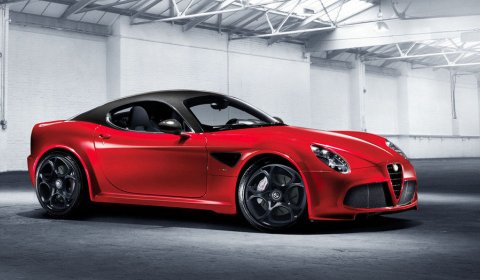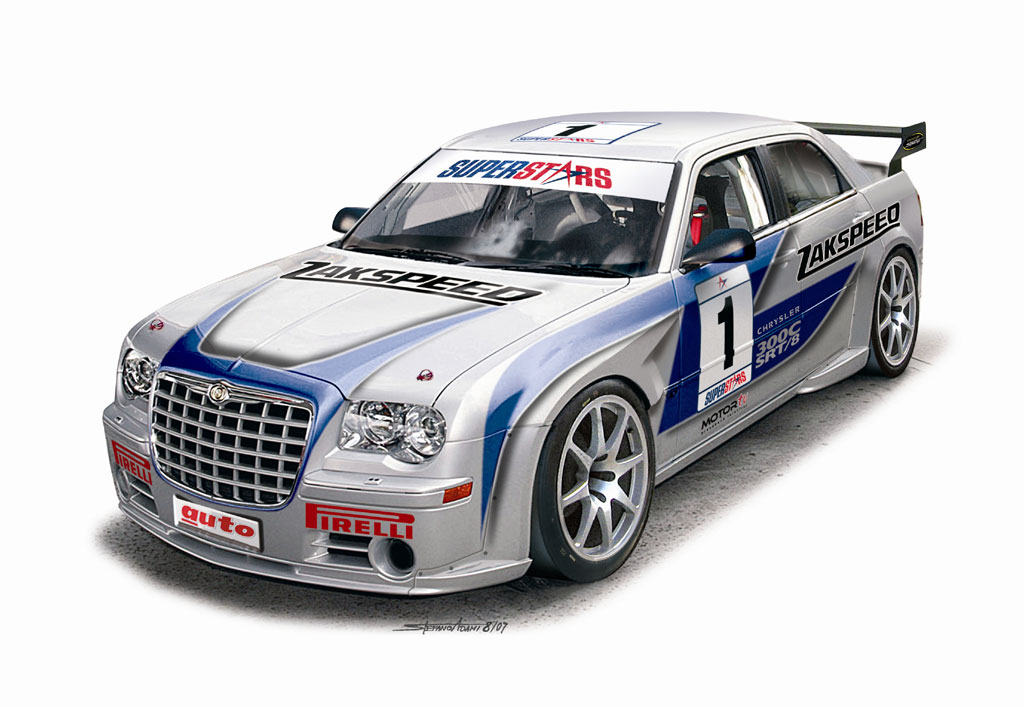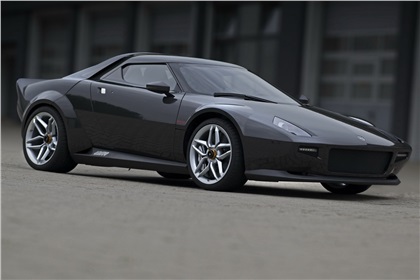 |
| 2011 Alfa Romeo 8c Competizione |
 |
| 2011 Alfa Romeo 8c Competizione |
Styling and aerodynamics: tradition and innovation
The attractive shape created by the Alfa Romeo Style Centre makes this car with its two bucket seats unique in the Gran Turismo scenario. The designers have worked hard to ensure that the aerodynamic and performance demands have not altered the car's original concept. The style maintains an incredibly clean shape, uncluttered by any element interfering with the overall harmony.
The solutions introduced on the Alfa Romeo 8C to achieve the highest levels of aerodynamic efficiency are not limited to the shape. Air wraps around the car and follows its natural course, unhindered by corners and unevenness. All the pillar and glass surfaces and profiles together with the door mirror shape and position have been optimised by mathematical modelling and also by wind tunnel tests and tests on actual models. Much attention has been devoted to the creation of a ground effect that has allowed a negative Cz (lift coefficient) to help increase stability at high speed, as on racing cars.
The compact dimensions concentrate the aggression of a car designed to ensure maximum driving efficiency.
The car surfaces are highly sculpted and skilfully moulded. In detail, the body is given extra dynamism by the horizontal furrow cut into the side above the front wheelarch. The big wheels and powerful musculature of the rear wings emphasise the model's personality and strength without detracting from the lines that flow smoothly, almost as though to underscore the formal good looks of the individual exterior details: the drop-shaped headlight embedded, gem-like, in the front wing, the led tail-lights that are a blend of technology and rationalism, the spare door handle. The front end still displays the distinctive Alfa Romeo traits, with a new interpretation of the 'whiskers' and shield.
The innovative shape heralds the details and proportions of future Alfa Romeo cars but is also redolent with past thrills and historical allusions: the 33 Coupé Stradale, the Giulia TZ and many other great names of motoring history. The Alfa Romeo style centre also developed new colours to emphasise the shape of the Alfa Romeo 8C Competizione that match the car's sinuous shape while also suggesting modernity and a hint of technology.
8 cylinder 4.7 engine: Italian 'belcanto'
The engine is the beating heart of any Alfa Romeo. In this case it takes the form of a brand new 90° V 8 cylinder unit with a cylinder capacity of 4691 cc that was designed with one aim in mind: to ensure extraordinary performance while still offering a smooth drive and being usable in all circumstances, from the track to city traffic.
The top engine performance figures may be summarised as a maximum power output of 450 bhp at 7000 rpm, a peak torque of 470 Nm at 4750 rpm and a top speed of 7500 rpm.
The layout of internal fluid movements and the cylinder head cooling system is designed to achieve high duct permeability and effective intake load cooling to maximise volumetric efficiency and engine performance.
Harmonisation of the intake and exhaust geometry together with the introduction of continuous variable valve timing on the intake camshafts and optimisation of the combustion chamber and engine calibration means that 80% of torque is available from 2000 rpm.
In sporty driving conditions over mixed routes, the power unit offers impressively short response times due to the high permeability of the intake duct and the low inertia of the flywheel-twin plate clutch system.
A crankshaft with counterweights at 90°, fully balanced through careful selection of connecting rods and pistons, ensures the engine runs with low vibration levels.
The engine block and base assembly is in aluminium with 5 main bearings to ensure the structure is very rigid with little loss due to friction. The cylinder heads are also in aluminium alloy.
All the ducts (water, oil, secondary air) are cast directly into the engine to produce a system with great rigidity, low dimensions and guarantees of safe installation, i.e. great reliability.
Casting accessory systems into the main engine casting and the use of very rigid, thick-walled components ensures that little noise radiates from the engine and the components are very reliable.
Longitudinal engine packaging has also received particular attention, as evidenced by the introduction of a single chain timing system that guarantees exceptional lifetime dependability.
Special attention has also been devoted to the acoustic definition and tuning of the intake and exhaust in the quest for a sound timbre that enhances the car's character and makes it unmistakable. The result is a full, distinctive sound, emphasised by the permeable intake system and an exhaust system with electronically controlled valves that enhance the car's sound without infringing any type-approval or environmental constraints.
Transmission, robotised gearbox and self-locking differential
The engineers used a layout familiar from other Alfa Romeo cars on the 8C Competizione: the transaxle architecture with gearbox at the rear that is an acknowledged asset of Alfa Romeo cars. This layout allows outstanding dynamic performance while also offering the active safety for which Alfa Romeo cars are fabled.
The engine-gearbox unit is designed in accordance with a transaxle configuration that ensures the weight distribution is very effective for vehicle handling. Due to the small axial engine size and the integration with frame components from the drawing board, the entire power unit can be housed well back to ensure the required sporty configuration.
The 6-speed gearbox with computerised speed selection by means of levers behind the steering wheel is designed to ensure ultra-slick gear shifts and may be used in Manual-Normal; Manual-Sport; Automatic-Normal; Automatic-Sport and Ice modes. The self-locking differential allows acceleration and stability to be managed with extraordinary efficiency in all situations.
Suspension, wheels and braking system
In the very best Alfa Romeo tradition, the engineering is directly derived from the race track. The suspension on the new model is no exception, with a double wishbone layout, forged aluminium axle carrier and arms and extra strut for toe-in control.
The braking system offers perforated, ventilated discs with aluminium brake callipers to ensure prompt, effective braking even with heavy use. To ensure the car stays glued to the road, it is fitted with 20" tyres specially developed to ensure outstanding performance: 245/35 at the front and 285/35 at the rear, fitted on perforated rims in fluid moulded aluminium to ensure lightness and maximum brake ventilation efficiency.
To ensure the car is entertaining and safe in any driving condition, the Alfa Romeo 8C Competizione comes with the latest Alfa Romeo VDC, an advanced stability and traction control system to ensure the driver feels at one with his car.
Rigid, light structure
A rigid, light structure is the rule when configuring a good high performance car. This is also the guiding principle behind the Alfa Romeo 8C Competizione. In detail, the compact frame is in steel to achieve the greatest torsional rigidity to ensure an accurate, safe drive at all times while the body is in carbon fibre. This choice was motivated by the need to minimise weights while also optimising the car's centre of gravity for better agility and handling on demanding routes.
Interiors: personality and technology
The car's distinctive look comes from extensive use of composite materials on the facia and interior panels. This is a technical choice but also reinforces the car's spirit and emphasises its personality. The same thinking lies behind the adoption of anatomical seats made out of carbon fibre that can be adjusted and customised on the basis of the driver's physical characteristics (a facility previously reserved for racing cars).
Everything is designed and produced to ensure the greatest user-friendliness for the driver and whoever is lucky enough to share the thrill: relaxed driving position, intuitive instruments that are always visible, robotised gear levers secured to the steering column and easy to reach without removing your hands from the sporty steering wheel.
The carefully-crafted and detailed finish naturally allows the car to be customised to the driver's taste and a choice of different interior environments is available.
The absolute satisfaction of a sporty drive
To see it is to love it: wide tyres, low-slung ride and styling of poised aggression. To die for, in fact. Hear the engine and weep: a full, convincing throaty roar. Now all that remains is to sit behind the wheel, engage first gear and you are off to try out your Alfa Romeo 8C Competizione. You are left with one doubt: how will you drive a sports model whose bonnet conceals a 4700 cc eight cylinder engine hat unleashes 450 bhp of power and 470 Nm of torque when you touch the accelerator. The unexpected answer is: with great ease - even more easily, simply and instinctively than your normal car in fact. Provided you allow yourself the time and satisfaction (because this is about pleasure, after all) of getting used to the more direct controls and prompter responses: the sort you could only expect from a true sports car on mixed routes or - even more so - on the track where speed and transverse acceleration are much more controllable.
The new Alfa Romeo 8C Competizione is self-avowedly an Alfa in its uncompromising sense of control and driving satisfaction. Driving comfort and dynamic behaviour have always been specific features of Alfa Romeo cars: on this car, they amount to a real strength.
Alfa Romeo 8C Competizione: a legendary name for a unique car
Since the very beginning, the Alfa Romeo spirit has been driven by a constant quest for technical perfection, achieving performances that are better and better. This is all about the engine: the beating heart of every Alfa Romeo car. Racetracks throughout the world have provided the perfect backdrops for truly unique technical and technological progress, with Alfa Romeo always occupying the highest position on the winners' podium.
The key to Alfa Romeo's engineering prominence was the 8 cylinder engine developed during the first half of the Twenties by a young engineer named Vittorio Jano. His original brief was to revise the 6 cylinder engine to meet the needs of standard production model buyers and also to stand up to the competition offered by rival manufacturers in races.
The first 8C was tested in 1923, with the P1, already fitted with a compressor and twin spark ignition, and then the P2. Its debut could not have gone better: in 1925 the Alfa Romeo P2 won first place in the first World Championship. The positive effects of these innovations were not restricted to the engines of production cars but the glory of this result was included in the 'Alfa Romeo - Milan' badge in the form of the laurel crown that was to adorn all Alfa Romeo cars from that day on.
At the beginning of the Thirties, the powerfully reliable 8 cylinder engines - now in light alloy - purred like cats under the bonnets of stylish cabriolets and coupes (whose bodies were built by the Milanese Zagato and Castagna) and roared like lions in the dust of races such as the Mille Miglia and Targa Florio, that added to the impressive list of victories. The thrilling wins achieved by the Alfa Romeo 8C in 1931, 1932, 1933 and 1934 at Le Mans deserve special attention (the car was later called the 'Le Mans' in the wake of these great successes).
The 8 cylinder engine achieved its technical peak in the Alfa Romeo Tipo B engine, known as the 'P3' to highlight its technological relationship with the P2. Campari, Nuvolari, Caracciola, Borzacchini, Marinoni, Guidotti and Fagioli were just some of the champions who owed their successes to the 1932 and 1934 versions of the 8C engine in the face of the challenges posed by the most prestigious circuits in the world.
The continual progress and consistent technical research culminated in the 8C 2900, the unbeaten star of racing from the Mille Miglia to the Le Mans 24 hour. The car, an extremely stylish 8C with its body built by Touring especially for Le Mans, was driven peerlessly by its driver Biondetti. This engine was exceptionally long-lived: an 8C 2900 B driven by Biondetti and Romano won the Mille Miglia again in 1947, proving yet again and over an exceptionally arduous route, that Alfa Romeo engines were possessed of truly extraordinary power and reliability.
World War II only halted the victorious progress of the 158 for a short period. The legendary 'Alfetta', a distillate of superlative automotive engineering qualities, first saw the light in 1946. In the words of Juan Manuel Fangio, driving this 8 cylinder car was like 'holding the bow of a Stradivarius in your hands'. First the 158 and later the 159 brought Alfa Romeo laurels in the first two modern Formula 1 world championships, with Nino Farina in 1950 and with Fangio in 1951.
After the Formula 1 victories, Alfa Romeo decided to withdraw from racing to devote itself to the demands put on it by its latest arrival, the 1900 and later the Giulietta range. 1967 saw the return of the powerful 8 cylinder engine fitted to racing 33 models and responsible for the attractive, resolute shape of the road version of the 33. This car also enjoyed a very encouraging racing debut, with Teodoro Zeccoli taking top position on the winners' podium after the uphill race in Fleron, Belgium, in a 33/2 Sport Prototype.
Other 33 cars met with considerable success on tracks and circuits throughout the world during the Seventies. This technical perfection was transferred to standard production cars such as the Montreal, a car of great prestige and performance, whose 8 Cylinder engine was derived from the unit fitted to the 33 models used for racing. In 1977, the 8 cylinder engine was fitted to a limited series of the Alfetta GTV, produced by Autodelta which thus continued the sporting tradition applied to engine production.
 |
| 2011 Alfa Romeo 8c Competizione |
 |
| 2011 Alfa Romeo 8c Competizione |
 |
| 2011 Alfa Romeo 8c Competizione |



















